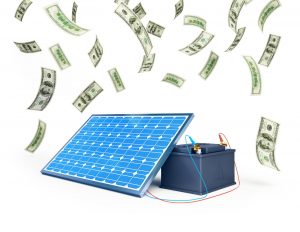Much has been made of the Federal Government’s contribution to the solar boom by way of the Investment Tax Credit. As of January 1, 2020, 26% of the cost of going solar is paid for through this tax incentive.
So, how does it work?
Let’s dig in and look at an example…..
David Smart decides to go green. He and his family are paying too much for electricity and have been concerned about the rate increases that are coming way too frequently.
The Smart family has a household income of $105,000. David and his wife Lynn both work as W2 employees and have a total of $1500 per month ($18,000 per year) in federal tax withholdings (FICA).
Based upon their deductions, David and Lynn’s CPA let’s them know that they will owe $17,250 in federal taxes come tax time. Fortunately, their employers have withheld a total of $18,000. So, the Smart’s will be receiving a tax refund of $750!
But, during the year, the Smart’s had a 7.2 kw solar system installed on their home, by local solar company Aurora Energy. The total cost was $32,850. Their solar advisor helped them finance all of the system and they reduced their cost of electricity by 38%. The Smart family has been spending about $245 per month for electricity. Now they will replace that bill with a new solar bill of $151. Smart move, Smarts!
Back to taxes.
The family CPA alerts the Smart’s that, in addition to a $750 tax refund, they will receive an additional $8,541 (solar cost of $32,850 X 26%) in refunds as a result of going solar. The Smarts are thrilled.
They start thinking about how to spend this windfall. Then Lynn remembered something. Their Aurora Energy solar advisor spent a lot of time explaining how all this works. She reviews the proposal and something clicks. The Smarts will indeed receive a solar tax credit of $8,541 and have a few options with this money.
*The Smart’s can roll the $8,541 back into their loan which will lock their bill in at $151.
*The Smart’s can keep the $8,541 and their solar bill will increase to $206.
*The Smart’s can roll part back into the solar loan and keep part (they have $4,200 left on a car loan that they want to get paid off).
So, the Smarts decide to keep $4,200 and pay off their car loan. The rest goes into the solar loan, and they lock in a solar payment of $178. Considering that they were paying $245/month for traditional power, paying off a car and still reducing their power bill to $178 seemed like a very smart idea, indeed. While utility costs will continue to rise, the Smart’s have locked in a fixed payment of $178 and paid off a car loan.
Solar lenders generally price monthly payments assuming that the homeowner will take their tax credit and roll it back into the loan. If they do, their cost for electricity will stay the same for the duration of the loan. If they don’t, then the payment will go up. Your tax advisor is the best resource to see if the solar tax credit is right for you.




